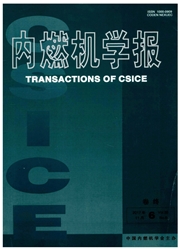

 中文摘要:
中文摘要:
在一台改造的单缸发动机上开展了进气道喷射汽油、缸内直喷柴油的双燃料燃烧模式的低速高负荷扩展研究.结果表明:汽油/柴油双燃料发动机高负荷工况需配合高比例废气再循环(EGR),当采用原机相同工况的进气压力时,由于进气量不足抑制了高EGR率的应用,导致高NOx排放.通过提高进气压力,稳定燃烧对应的柴油喷油时刻范围变宽,汽油比例上限提高,降低了燃烧控制的难度.但由于汽油/柴油双燃料发动机的汽油高度预混合特性及直喷柴油引起的局部不均匀性,导致缸内最大压力升高率(MPRR)及碳烟排放偏高,限制了其向更高负荷的扩展.在提高进气压力的同时,通过提高汽油比例及EGR率,实现了在限定条件下向更高负荷的扩展及燃油消耗率的降低.相比于原柴油机,汽油/柴油双燃料发动机高负荷扩展的受限因素由进气增压前的高NOx排放转变为增压后的高压力升高率.
 英文摘要:
英文摘要:
Extension of high load at low speed fuelled with gasoline/diesel dual fuel was investigated on a modified sin- gle cylinder engine. This dual-fuel combustion mode proposes port fuel injection of gasoline and direct injection of diesel fuel. Experimental results show that high proportion of EGR is necessary for the gasoline/diesel dual-fuel engine at high load. If the intake pressure of origin engine under the same working condition is adopted, the EGR ratio is hard to in- crease because of the deficiency of air introduced, resulting in increasing of NOx emission significantly. Increasing in- take pressure will widen the range of diesel injection timing and the maximum gasoline ratio will increase for the steady combustion, and combustion control becomes easy. However, because the gasoline/diesel dual fuel engine forms highly premixed mixture of gasoline and the direct injection diesel fuel may cause partially inhomogeneous in cylinder, the maximum pressure rise rate(MPRR) and soot emission are increased, limiting the operation range to a higher load. Therefore, increasing intake pressure and adding gasoline ratio and EGR ratio can realize the extension of opera- tion range to a higher load and decrease the indicated specific fuel consumption (ISFC). Compared with the origin engine, boosting intake pressure, the limiting factors of high load extension of gasoline/diesel dual fuel engine shift from high NOx emission without boosting intake pressure to high pressure rise rate with boosting intake pressure.
 同期刊论文项目
同期刊论文项目
 同项目期刊论文
同项目期刊论文
 The Design and Optimized Combination of Combustion Modesover Full-Load Range in a Multi-cylinder Lig
The Design and Optimized Combination of Combustion Modesover Full-Load Range in a Multi-cylinder Lig Development of an n-heptane-n-butanol-PAH mechanism and its application for combustion and soot pred
Development of an n-heptane-n-butanol-PAH mechanism and its application for combustion and soot pred Study of the control strategies on soot reduction under early-injection conditions on a diesel engin
Study of the control strategies on soot reduction under early-injection conditions on a diesel engin Experimental study on combustion and emission characteristics of a diesel engine fueled with 2,5-dim
Experimental study on combustion and emission characteristics of a diesel engine fueled with 2,5-dim A semi-detailed chemical kinetic model of a gasoline surrogate fuel for internal combustion engine a
A semi-detailed chemical kinetic model of a gasoline surrogate fuel for internal combustion engine a Experimental and numerical study on different dual-fuel combustion modes fuelled with gasoline and d
Experimental and numerical study on different dual-fuel combustion modes fuelled with gasoline and d Development of an n-heptane/toluene/polyaromatic hydrocarbon mechanism and its application for combu
Development of an n-heptane/toluene/polyaromatic hydrocarbon mechanism and its application for combu Combustion and emissions of 2,5-dimethylfuran addition on a diesel engine with low temperature combu
Combustion and emissions of 2,5-dimethylfuran addition on a diesel engine with low temperature combu 期刊信息
期刊信息
